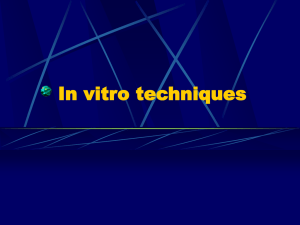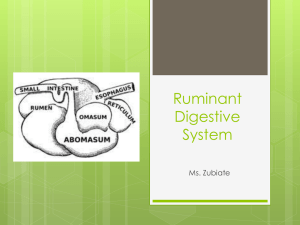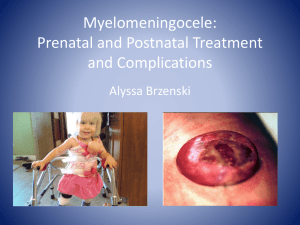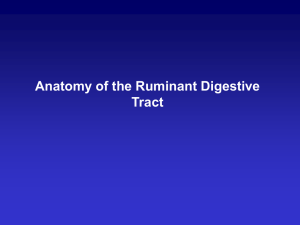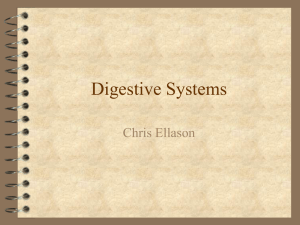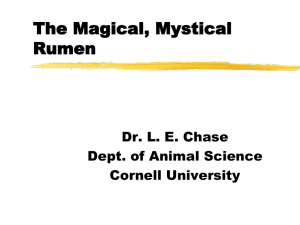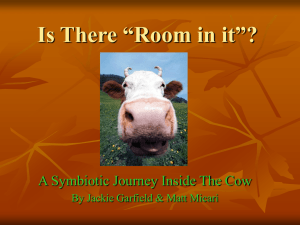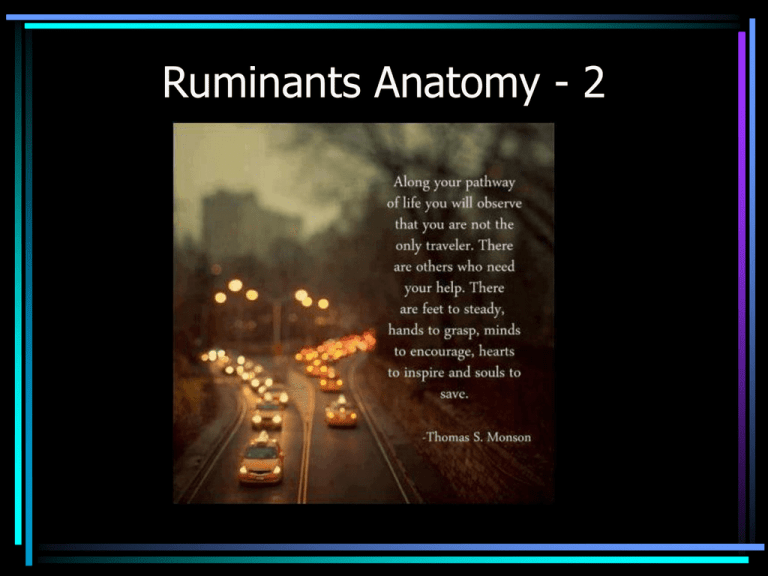
Ruminants Anatomy - 2
Objectives
• Reproductive anatomy and Mammary
Physiology
– Chapter 3
• GI anatomy
– Personal notes
The Importance of Reproduction
• Deliver live neonates
– Breeding estrous cycle determinations,
reproductive exam, AI, embryo transfer,
live cover
• Genetics,
– Gestation
– Delivery
• Economics
Selection
• Estimated progeny differences
– Uses: in males
– EPD values: birth, growth, maternal, and
carcass traits and are reported in the same
units of measurement as the trait
(normally pounds)
– Accuracy: only in same breed. 1 is good
and more accurate with more progeny data
Selection
• Estimated breeding values
– Uses: value of breeding
– Differences between EPDs and EBVs
• EBV also adds potential for heritability
• Pedigrees: more in equine
– Breeding systems: inbreeding, linebreeding,
crossbreeding (angus+hereford = black brockle
face), purebreeding (same breed), outcrossing
(different families, same breed) and grading up
(grade animal: no documentation of lineage +
pure breed)
• Conformation: good udder and footing, not
cryptochidism
Reproductive Physiology: Table 3-2
Estrous
• Proestrus
– Declining progesterone
– Gonadotropin releasing
hormone (GnRH) and
follicle-stimulating
hormone (FSH)
– Increasing estrogen
– Follicular growth
• Estrus
– Peak estrogen
– Luteinizing hormone
– Ovulation
• Metaestrus
– Estrogen decreases
– Progesterone
increases
• Diestrus
– Progesterone is high
– Prostaglandin
released if
conception does not
occur
– Destruction of the
corpus luteum
Breeding Soundness Examination
• Purpose: assess fertility
• Examination: before breeding season
– Preparation: Safety (chute)
– Penis and prepuce
• Tranquilize to relax retractor penis muscle
– Scrotum and testicles
– Measurement of scrotal circumference
– Breeding behavior
– Semen analysis
Prolonged penile extension: phenothiazine based tranquilizers:
e.g. acepromazine, chlorpromazine, and promazine
Fibropapilloma:
warts
NB: permanent damage if out more than 2 hours: penile paralysis,
Phimosis (swelling prepuce), paraphimosis (swelling prepuce/penis),
Priaphism: blood cannot exit glans penis: swelling penis/penis
Bull Age (months)
Size (cm)
12 - 14
30 - 34
15 - 20
31 - 36
21 - 30
32 - 38
> = 31
34 - 39
Semen Collection and Preparation
• Collection
– Electroejaculation
– Artificial vagina
– Natural stimulation
• Preparation
Optimum temp
Semen Analysis
• Shake container
• Keep warm: 37 C/
98.6 F)
• Protect from UV
light: warm water
bath
• Use gel free fraction
of ejaculate
• Extenders: protein,
Sugars, antibiotics
• cryopreserve
Parameter
Normal Values
Ejaculate volume
5 ml (range 1-15 ml)
Sperm concentration
1200 million/ml (range 3002500 million/ml)
Total sperm per ejaculate
Typically 4-5 billion
Progressive motility
Greater than 30%
Morphology
Greater than 70% normal
Semen samples from a bull (left)
and dog (right),
showing differences in opacity and
concentration
Insemination Timeline
Sperm Viability
12 to 30 h
sperm transport
6h
Ova viability
8 to 12 h
24 - 32 h
Onset of E strus
Ovulation
Estrous Cycle Determination
• Rectal palpation
• Vaginal examinations
– Not useful in cattle
• Ultrasound via rectum
– Better for horses
• Observation of
standing heat
• Vaginal cytology
Ovaries: Rectal palpation
Estrus: large soft follicles,
relaxed hyperemic cervix
KaMar/ Bovine Beacon
Tail Paint
Tail Paint
Other signs: swollen vulva, vaginal
discharge, increased vocalization,
frequent urination, restlessness
Heat Watch
1. Transmitter with pressure
sensitive button on top
3. The receiver accepts the mounting
activity signal from the transmitter
Receiver
2. Mounted onto cow’s rump
using a patch and adhesive
4. Information is transferred to
computer for processing by
HeatWatch software.
Estrus Synchronization
• Ovsynch uses two hormones
– PGF2α and GnRH
• Ovsynch occurs in three stages
– Day 0 - Stage 1: GnRH injection to create a new
follicle
– Day 7 - Stage 2: PGF2α injection to end the
current estrus cycle and regress the corpus luteum
– Day 9 – Stage 3: Second GnRH injection to cause
the new follicle to ovulate and release the egg
• All cows will ovulate 24-32 hours after the
second GnRH injection
– Day 10 – Insemination
Lutalyse
• Lutalyse is a veterinary pharmaceutical brand name
• Lutalyse is a PGF2α therapy treatment
• If an animal is known to be open (i.e. her ovulated egg was
not inseminated), a shot of Lutalyse will end the cycle and
start a new one.
• Lutalyse/ PGF2α will cause the death of the corpus luteum,
resulting in reduced progesterone production.
• Pregnant women SHOULD NOT administer shots of
Lutalyse; it can cause their bodies to terminate the
pregnancy!
Estrus Synchronization
• CIDRs (Controlled Internal Drug
Release)
– intravaginal progesterone
– beef cattle, dairy cattle, goat and sheep
industries.
– released at a controlled rate
– beneficial in large herds
Breeding
• Live cover
• Prepare perineum/ vulva: cleanse with povidone
iodine
– Artificial insemination
– Embryo transfer: pathogen free embryos
AI pipette
Breeding (cont’d)
Breeding (cont’d)
• Embryo transfer
– Superovulation
• Ovulate multiple eggs
– Breeding: AI or natural
– Embryo recovery
• Phosphate buffered saline
– Embryo ID
– Embryo transfer: recipient
Pregnancy Detection
• Failure to return to estrus
• Rectal palpation
– 25 – 30 days
• Ultrasound per rectum
– 12 days
• Trans abdominal ultrasound
– 95% accurate: 60 days
• Doppler ultrasound
– Week 6-7
– Fetal heart rate
• External palpation
– Ballottement
– 7 months
• Abdominal radiographs: not common
• Laboratory tests: estrogen assays: blood, urine, milk
Rectal Pregnancy
•
Easiest, fastest, cheapest
–
•
•
status 25 - 30 days post breeding
– US: 12 days (18 days in small
ruminants)
– Radiograph: 90 days
Positive signs of pregnancy
– Fetus
– cotyledons/caruncles
– amniotic vesicle
– fetal membrane slip
Suggestive signs
– Ipsilateral corpus luteum
– Ipsilateral middle uterine artery
in the broad ligament
US: 40 day pregnancy
Fetal Membrane Slip (be
gentle, as you can damage a
pregnancy by rough
palpation)
32 days thread 1 horn
45 small string 1horn
60 string 2 horns
>70 large string
Pregnancy - Cotyledonary
• Placentomes
– cotyledon/caruncle unit)
– You must rule out that you a not
palpating an ovary by feeling at
least 3.
The fetus descends out of reach from 3-7 months.
You can first feel the fetus at 55-60 days
To estimate an aborted fetus they are:
2 months mouse
3 months rat
4 months small cat
5 months large cat
6 months beagle dog
75 days pea size
100 dime
115 nickel
125 quarter
150 half dollar
> 150 variable
•
•
•
•
•
Gestation: Avg. 283 days
1 – 2 days before parturition:
elevated tail head
Stage I: Preparatory stage
•
~ 6 hours
•
Inappetance, restlessness,
kicking belly
Stage II: Delivery
•
30 min – 4 hours (Avg. 75
minutes)
•
Heifers take longer
•
Head diving posture
Stage III
•
Expel placenta
•
4 – 12 hours
•
PE calf
Dystocia
• Fetal or maternal: emergency
– Fetal more common
• Malformation – “fetal monsters”
• Stillbirths
• Large fetal size
• Fetal malposition
– Maternal
• Compromised pelvis: fracture/ old injury
• Uterine torsion
• Rupture of supporting structures
Dystocia
• 3 approaches: LUBE!!!
– Mutation and traction
• Obstetrical chains, calf jacks
– Fetotomy: in cattle
– C – section
• Fetus too large, small pelvis, cervix does not
dilate, vaginal prolapse, dead fetus, malformed
fetus
Dystocia
Dystocia
• C – section
– Large fetus
– No vaginal
manipulations
– Failure of cervix to
dilate
– Vaginal prolapse
– Fetal emphysema
– Fetal monster
Separate Mammary Glands-Quarters
60%
40%
REAR
Front quarter is smaller
Fig 29-3. An illustrated view of the ligaments that permit
udder suspension (Courtesy of Iowa State University)
Mammary Gland Structure
• Udder: 4 separate glands
– A teat hangs from
each quarter
• sphincter muscle
known as streak
canal
– extra nonfunctional
teats
• supernumerary
teats
• Removed in calf
Internal Anatomy
• Streak canal
– bacteria out
• Teat cistern
– Duct in teat : 30-45 milliliters
– Separated from streak canal: Furstenberg’s rosettes
• Gland cistern
– Separated from teat cistern by the cricoid fold
– 400 ml of milk
• Collecting area for the mammary ducts
Fig 29-4. A dissected mammary gland showing the gland cistern,
teat cistern and streak canal (Courtesy of Mark Kirkpatrick)
1 gallon of milk: 400 gallon of blood
• pudic arteries
• external pudic veins
and subcutaneous
abdominal veins
Fig 29-6. Blood flow to and from the mammary
gland determines milk producing capability of the
cow (Courtesy of Iowa State University)
Digestive System
• Cranial fermentors
– Forestomach
– E.g. cattle, sheep and deer
– digest and extract energy from
cellulose
– utilize the protein from fermentative
microbes
• Caudal fermentors
•
•
•
•
Cecal digestors
E.g. horses and rabbits
digest and extract energy from cellulose
utilize dietary hexose sources directly
Digestive system calf
• Esophageal groove
– By pass reticulum
and rumen and
goes directly into
abomasum
– Grain and forage
for rumen
development ~ 3
weeks age
Fermentation Ecology
•
Rumen inoculation
– 1 ml of rumen content: ~10 to
50 billion bacteria,1 million
protozoa, variable numbers of
yeasts and fungi
– Cellulolytic (digest cellulose)
– Hemicellulolytic (digest
hemicellulose)
– Amylolytic (digest starch)
– Proteolytic (digest proteins)
– Sugar utilizing (utilize
monosaccharides and
disaccharides)
– Acid utilizing (utilize such
substrates as lactic, succinic
and malic acids)
– Ammonia producers
– Vitamin synthesizers:
vitamin B and K
– Methane producers
Poor nonprotein
nitrogen such as urea
to produce VFA, AA, Vit
B and K, methane, CO2
Fermentation Ecology
• Rumen pH between 6 and 7 (6.2 – 7.2):
Transfaunation
• Grain engorgement: pH <5.5
– protozoal populations decrease
• Products: Sugars -> VFA’s
– acetic, propionic and butyric acids
Volatile Fatty Acids
• Acetic acid
– generate ATP
• Proprionic acid
– major substrate for
gluconeogenesis
• Butyric acid,
– for energy
production.
Ruminant Anatomy
• the rumen or paunch
• reticulum or
"honeycomb,"
• the omasum or “book,"
• the abomasum or "true
stomach."
• Esophagus > rumen reticulum > omasum >
abomasum
Reticulum – ‘honeycomb’
• against the diaphragm
(2.5 gal.)
• rumino-reticulum
connected by tissue
• Heavy objects fall
– Hardware disease
(traumatic
reticuloperitonitis)
• No enzyme secretion
• Formation of food bolus
Rumen – ‘Paunch’
• largest
• sacculated by muscular
pillars: dorsal, ventral,
caudodorsal and
caudoventral sacs
• stratified squamous
epithelium (Papillae
lining)
• fermentation vat (2542.5 gallons, anaerobic
bacteria)
• Absorbs most VFA
• Healthy cows: 1-2
minutes/contractions
Omasum - book
• broad longitudinal
folds or leaves
• Absorption of water
(4 gal.)
• Reduce particle size,
ingesta between the
leaves will be drier
than in other
compartments
Abomasum – true stomach
– True stomach with a
glandular lining (5 gal.)
– HCL and digestive enzymes
(proteolytic enzymens: mucin,
pepsinogen, renin, lipase),
needed for the breakdown of
feeds, are secreted into the
abomasum
– PH decreases from 6 > 2.5
• Denatures proteins
• Kills bacteria and
pathogens
• Dissolves minerals
H2O vital: Drink 10-14 gal./dy;
Dairy cattle at peak lactation: 45 gal. H2O/day (3-5 gal/ lb milk
Digestive system - Ruminants
• The small intestine
– measures about 20 times the length of the animal
– duodenum, jejunum, and ileum.
– Secretions: pancreas and the gallbladder, which aid
digestion
– Most of the digestive process is completed here
• Cecum
– SI and LI, where some previously undigested fiber may be
broken down
– Function of cecum?
• Large intestine
– last segment of the tract through which undigested
feedstuffs pass
– absorption of water is the primary
– Some bacterial digestion of undigested feed occurs
Function of digestive tract
• Eructation (belching)
– Large quantities of gas, mostly carbon dioxide and
methane, are produced in the rumen
• Rumination (4 phases)
– 35 to 40 percent of each day ruminating (cud
chewing)
– During rest periods, feed boluses (cud) are
regurgitated for rechewing to reduce particle size
and for resalivation.
– Feed is more readily digested by rumen microbes
as particle size is reduced
– Redeglutition: swallowing
Four Steps of Rumination
• Regurgitation
– Reverse peristalsis carries food to mouth
• Remastication
– Liquid squeezed from bolus and
swallowed
– Bolus chewed
• Reinsalivation
– Adding more saliva
• Redeglutition
– Swallowing bolus and liquids
Remastication
and Redeglutition
Digestive system - Ruminants
• Motility of the rumen and reticulum
– contractions mix Saliva production
– 50 to 80 quarts of saliva
– provides liquid for the microbial population,
recirculates nitrogen and minerals, and
buffers the rumen
– buffer for helping to maintain a rumen pH
between 6.2 and 6.8 for optimum digestion
of forages and feedstuffs
• Vomiting
– Rare: suspect toxins
References
• K Holtgrew-Bohling , Large Animal
Clinical Procedures for Veterinary
Technicians, 2nd Edition, Mosby, 2012
• Slides courtesy of Dr. H.D. Tyler, Iowa State
University
• References: Dr. M. A. Barnes, Virginia Tech and
Dairy Cattle Science. 4th Ed. 2005.
• http://www.vet.kstate.edu/studentorgs/bovine/pdf/Reproductive_
Physiology.pdf
• http://cal.vet.upenn.edu/projects/repropath/FNor
mal/ovaries/template.htm
References
• Large Animal Clinical Procedures, Elizabeth Hanie.
2006
• http://www.fsis.usda.gov/ofo/tsc/bse_information.ht
m
• http://www.fao.org/docrep/t0690e/t0690e05.htm
• http://www.infovets.com/books/smrm/C/C015.htm
• http://www.vivo.colostate.edu/hbooks/pathphys/dige
stion/herbivores/index.html
• http://www.extension.umn.edu/distribution/livestocks
ystems/components/di0469-02.html
• faculty.fortlewis.edu/LASHELL_B/Nutr2-
Rumdigestion.pdf
• http://www.das.psu.edu/researchextension/dairy/nutrition/calves/rumen
• http://www.pitt.edu/~super1/lecture/lec30761/006.h
tm
References
• http://www.vivo.colostate.edu/hbooks/
pathphys/reprod/semeneval/collection.h
tml
• Author: Dr. Dipa Brahmbhatt


